2020 might be the year of the fake sports fan.
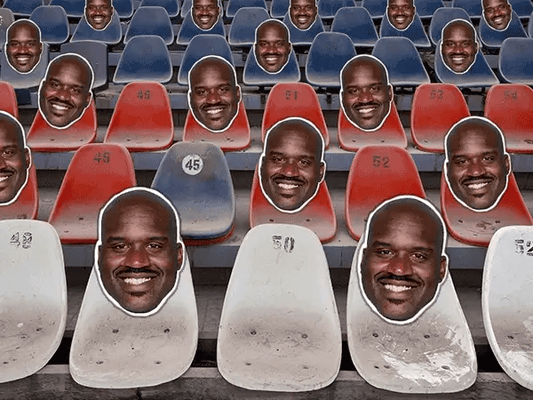
Once bustling with beer-soaked fans, stadiums across the world are now full of cardboard cutouts. Unable to attend games in person, diehard fans are ponying up $20 to $30 to have their photos printed out and affixed to the seats at Korean baseball games, German soccer matches, and more.
In the age of COVID-19, fake guests have become one-off oddities at restaurants and high school graduation ceremonies. But in the sports world, cardboard fans could be a game changer.
Major sports leagues are finally announcing their return. The NBA is gearing up to finish out its season in Orlando starting on July 31, MLS returns on July 8, the National Women’s Soccer League kicks off on June 27, and the NFL is still hoping for a September 10 start.
The catch? Not one of these leagues will be selling tickets. Exact numbers vary across leagues, but Georgetown professor Marty Conway estimates that ticket sales account for a considerable chunk of major leagues’ income:

The Hustle
This loss in revenue brings with it an opportunity for some kind of stopgap replacement.
Selling cardboard fans could be a small way to make up some lost revenue. And it might also give fans a viable way to support their favorite teams from afar.
The sports world is going all in on cardboard
Back in March, a German filmmaker and soccer aficionado named Ingo Müller was sitting at home, complaining to his wife about not being able to attend the matches of his favorite club team, Borussia Mönchengladbach.
“She said, ‘If you’re really pissed about not going to the stadium, just take a photo and send it there,’” Müller tells The Hustle.
So, Müller contacted a local printer and a team to build a portal where fans could upload photos of themselves. For a sum of €19 ($21 USD), he’d print out each photo on a cardboard cutout and install it in the stadium, with the permission of club owners. Originally, he anticipated between 500 and 2k orders.
So far, 21k+ people have purchased a cutout. All the proceeds go back to charities associated with the team, including a portion to fans impacted by the pandemic.
Now, Müller has received inquiries from sports teams in “at least 15 countries,” including Sweden, Colombia, China, Russia, Serbia, and Austria, about setting up their own cardboard fan project. He’s even decided to apply for a Guinness World Record.
And Müller isn’t the only one tapping into the trend.
Cardboard fans are lining the stands at baseball games in Taiwan and South Korea, and soccer matches all over Europe. Shaquille O’Neal’s cardboard likeness even turned up for a soccer match in Northampton, England.
At least 8 Premiere League teams have been in talks to fill their stands with cutouts. Turkish soccer clubs are trying a model with two price tiers: 123 liras ($18) for season ticket holders and 149 liras ($22) for regular fans. The results are a sight to behold.
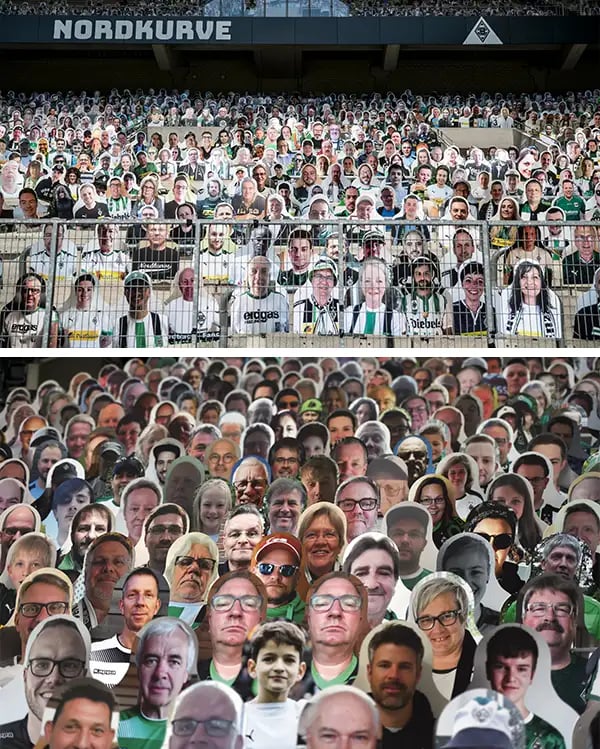
Cardboard cut-outs of fans of Bundesliga club Borussia Moenchengladbach fill their stadium on May 14, 2020 in Germany (photos by Christian Verheyen/Borussia Moenchengladbach, Ina Fassbender, via Getty Images)
For sports teams trying to recoup ticket revenue, cardboard fans aren’t the only idea in the mix. Using AR, an Iceland-based company, OzSports, is trying to project avatars of fans into seats. In Denmark, one team brought 10k fans into its stadium with Zoom. In South Korea, a soccer team filled its fan seats with actual sex dolls — a move that earned them widespread criticism and an ~$81k fine.
There are some pitfalls with printing fan-submitted photos en masse. At a recent rugby game in Australia, 4k supporters bought cardboard cutouts at about $22 each through the league’s Fan in the Stand initiative — including a prankster who uploaded images of a prolific serial killer, Harold Shipman. No one caught it before it aired on TV, and The National Rugby League responded with promises to tighten its screening process for photo uploads.
Nonetheless, over the last 6 weeks, cardboard fans have sprouted into a cottage industry.
Many of these new startups — Face Fan, Return To Sport, Fans At The Game — are based in Europe and are focused mainly on soccer. But several entrepreneurs are also attempting to make this a thing in US-based sports.
America, welcome to your cardboard future
My Fan Seats, launched in May, is one of the first to attempt to penetrate the US market. Its founder, Lara Smedley, is a 15-year veteran of sports marketing and events who has worked with college sports, the NBA, and MLS.
“We aren’t pivoting blindly,” Smedley says. “We are pivoting because we know some of the conversations that are happening at the team and league level.”
Though Smedley hasn’t yet produced any cutouts, she says she’s received “a couple verbal commitments” from clients, including at least one from a college football bowl game. These commitments come with one big caveat: Officials will only welcome cardboard fans if human fans are not allowed to fill seats in person.

Cutouts from My Fan Seats (photo via Lara Smedley)
In California, Be At The Game — the UK-based company that helped Borussia Mönchengladbach print and install 21k+ fans — is partnering with an independent soccer club called the Oakland Roots.
As cofounder Edreece Arghandiwal tells it, the Roots were formed in 2018 with a desire to reflect the diversity and camaraderie of the city. “We’re creating the concept of a sports club from the grassroots,” he says.
Before the pandemic, the team regularly sold out all of its ~6k seats. This season, its stands will be empty.
But starting with preseason games this July, the team plans to affix cardboard cutout fans to stadium seats at $35 to $45 each. Arghandiwal is calling the initiative the “Faces of Oakland.”
For him, the big draw of the cardboard fans is not just that they could offset ticket revenue. All those cardboard faces in the crowd? They’re a testament to the fans who have helped build their program.
Be At The Game, meanwhile, has been around since mid-May. One of its cofounders, Tom Hickson, doubles as the president of the World Dodgeball Association, and his sports Rolodex runs deep.
He’s landed contracts with soccer and rugby leagues in the UK, but lately he’s turning his attention to US leagues. Although Hickson says he’s been in touch with the NBA and the NHL, his real focus is on colleges and minor league teams. Those smaller teams are the closest to their fan communities — and they’re the ones who see cardboard cutouts as Hickson does.
“What matters is we’re trying to bring communities together to celebrate the restarting of sport,” he says.
That’s what makes Oakland Roots a prototypical partner. It’s donating a portion of the proceeds to social justice causes in the community. “We don’t ever make a decision just based on financial value,” says Arghandiwal. “Can we give back to local organizations? Can we create some kind of local movement?”
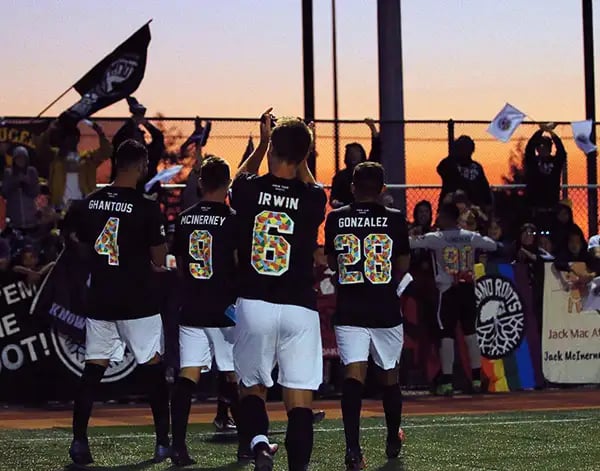
The Oakland Roots, pre-pandemic, in front of their fans (photo via Oakland Roots Facebook page)
But the club’s real ambition comes after their fall season ends. While most cardboard fan companies will send you back the cutout after the season ends, Oakland Roots wants to turn all of those cardboard fans — all of those faces of Oakland and beyond — into a series of collages to be placed around the city.
It’s a physical encapsulation of the city’s resilience through the pandemic.
So, how does this all work?
This entire burgeoning ecosystem of cardboard cutouts is, of course, dependent on one thing: fans’ willingness to purchase them.
I wanted to find out how this whole process works. So, on a recent Sunday, I decided to buy a cardboard cutout. I chose my dad — the closest person to a sports fan in my immediate circle — and a team: Colchester United, a smaller soccer club in the UK.
Colchester United had partnered with a sports advertising company called The Football Company, which was pivoting to selling recyclable, waterproof fans through an initiative called Fans at the Game.
It only took about 2 minutes to place the order: I visited the portal on the Colchester United website, and I snapped a photo of my dad within a silhouette border. The silhouette was fitted to the size of the standard UK stadium seat. After paying £25 ($31 USD), I was given a game date: My dad would be in the stands for the match against Exeter City that Thursday.
There was no email showing me what my dad would actually look like on cardboard. No follow-up note that my dad’s cardboard doppelganger had been printed.
Cue the sinking realization: If I wanted to see the fruits of my £25, I was going to have to find my dad on the live-stream myself.
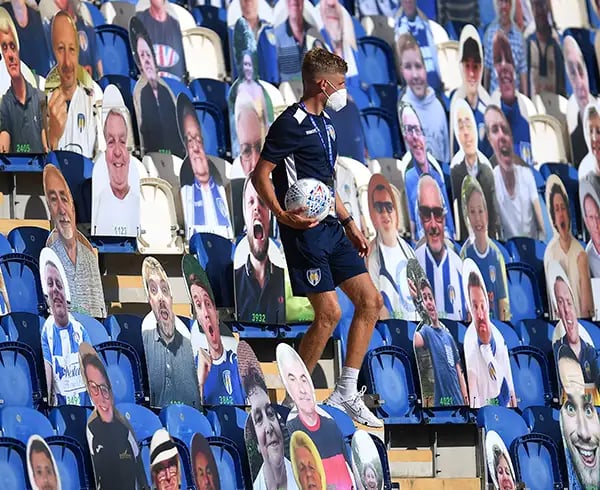
A ball-boy retrieves a ball from amongst cardboard cut-outs of fans during a match between Colchester United and Exeter City (photo by Justin Setterfield/Getty Images)
I wasn’t the only fan at the game. Si Collinson, a Colchester United fan based in the UK, bought 5 cutouts for Thursday’s match — 1 for himself, 4 for his family members.
“It was a great way to show support for the players but also to give the club another form of revenue during these strange times,” Collinson told me this week. “As a family we have been lifelong supporters. My 3-year-old son already has a season ticket.”
Another big draw: When the season wraps up, Collinson can take home all 5 cutouts — he expects it will be “a nice memento of what has been a season to remember.”
Derek Corton, a Nottingham Forest supporter, sent in a photo of his late father. The picture he chose: His dad in Cologne, Germany, in 1979, supporting Forest at the European Cup semifinals. To Corton, the cutout is a way to honor the man who got him into soccer in the first place. “I will definitely be on the lookout for my dad while hopefully cheering Forest onto a win,” he says.
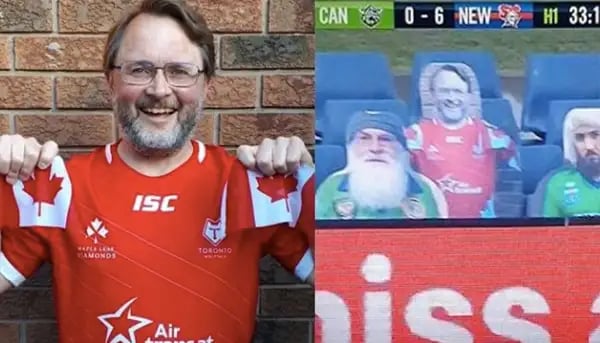
Left: Nicholas Mew in Canada, submitting his cardboard cutout. Right: Nicholas Mew spotted in the stands in Australia (photos courtesy of Mew)
Nicholas Mew, a rugby lover in Ontario, Canada, bought a cardboard cutout for the Melbourne Storm — a team based in Australia. Australia’s National Rugby League, Mew says, is “the only game in town” right now.
But he decided to buy a cutout above all as an act of international diplomacy. In the photo he submitted, he wore a jersey for the Toronto Wolfpack, his native rugby team. “I wanted to wear my Wolfpack jersey and have the team be seen in Australia, and to hopefully build some goodwill for Toronto down under,” he says. “Crack peoples’ awareness.”
After some internet scouring, Mew found himself on TV. A photo of him in the stands wound up, in all places, in a Toronto Wolfpack Facebook group.
My reasons for buying a cutout of my dad were much less sentimental. And maybe that’s what did me in. On Thursday at noon, I scoured the in-game audience for any glimpse of my dad — including toggling through photos on Instagram and Twitter after the fact. No luck. I did, at least, catch a canine supporter:
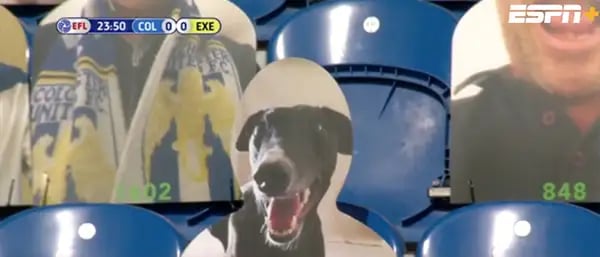
Screenshot of the Colchester game, via ESPN+
I was feeling pretty down about it until Collinson — the Colchester fan — emailed me less than an hour after the match ended. He was only able to spot 2 of the 5 cutouts he’d purchased in the crowd.
But it hardly mattered. Collinson was just thrilled to have soccer back. “What a scrappy game,” he wrote. The final score: A narrow 1-0 win for Colchester United.

